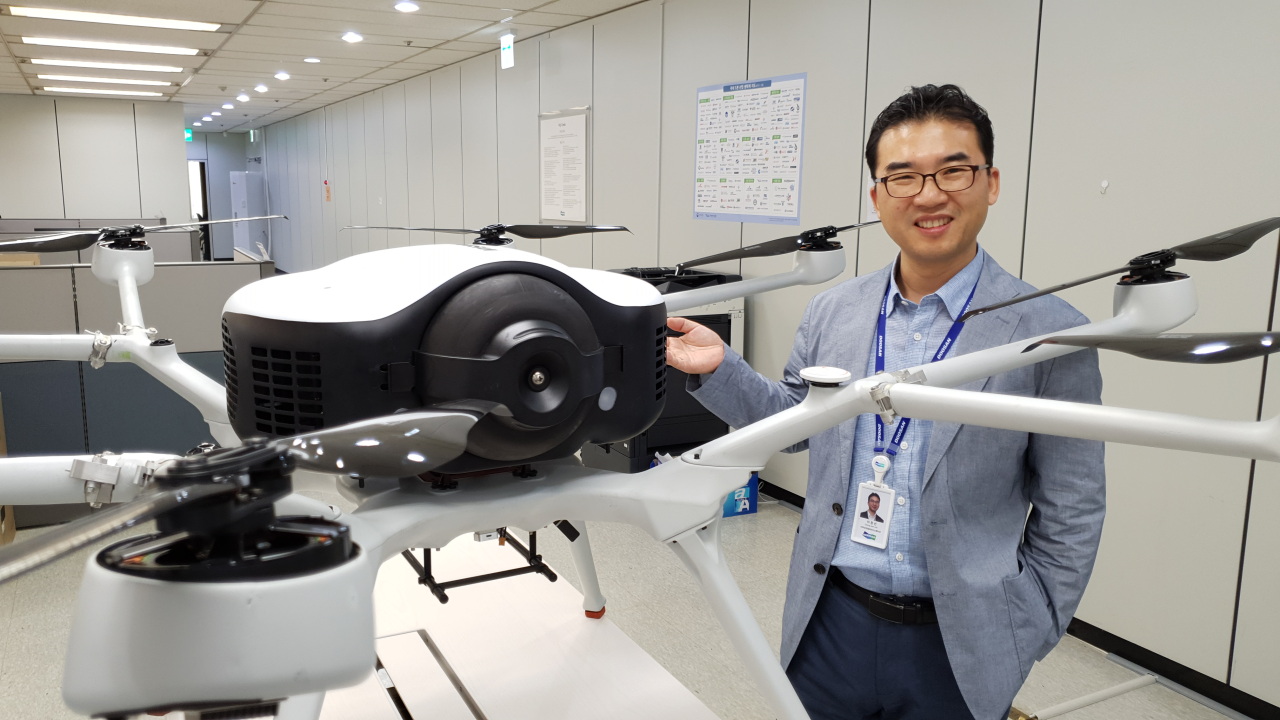The Korea Herald is publishing a series of articles on South Korea’s latest measures to support the hydrogen economy, a market drive for hydrogen-powered vehicles and the hurdles that stand in the way. This is the eighth installment. -- Ed.
YONGIN, Gyeonggi Province -- At first sight, the DS30, a hydrogen-powered drone developed by Doosan Mobility Innovation, a subsidiary of South Korean conglomerate Doosan Group, resembles a giant spider with eight long legs.
The 2.6-meter-long and 80-centimeter-high aviation vehicle, however, weighs only 20 kilograms, even with a hydrogen tank comprising multiple high-strength layers loaded with plastic, carbon fiber and fiberglass.
“The entire body is made of carbon fiber with components made of aluminum and magnesium as well as stainless steel,” said Doosan Mobility Innovation Vice President Lee Chang-seon, while unveiling the DS30.
“You can never apply green technology (battery or fuel cells) used in cars to drones. It should be as light as possible, because drones move vertically. The weight matters a lot more than cars.”
Most fuel cell stacks require a cooling system. For cars, water is typically used to lower the temperature, but Doosan came up with the idea of air recirculation to keep the DS30 light, while enhancing fuel cell efficiency, Lee said, noting that it’s the core technology of the drone.
The use of hydrogen as the drone’s energy source, has indeed pushed the limits of unmanned aviation vehicles. Drones powered by heavy lithium-ion battery can only fly half an hour, but Doosan’s DS30 can do so for two hours, Lee said. Flying at the speed of 10 meters per second, the DS30 can fly 72 kilometers on a single charge, significantly expanding the range of what drones can do.

Doosan Mobility Innovation Vice President Lee Chang-seon presents the DS30, hydrogen-powered drone set for world debut next month, in his office in Yongin, Gyeonggi Province. (DMI)
“The limited travel time has curbed the role a drone can play. (For now) it is important to develop new technology, rather than on enhancing its loading capability,” he said.
Developed over 2 1/2 years, based on Doosan’s strength in fuel cell technology, the DS30 can cover all areas of Seoul, or within a 36 kilometer radius. It can be dispatched to mountainous areas to transport blood or drugs or instantly sent to monitor or initially deal with natural disasters or maritime accidents, he said. The company has partnered with Korea Electric Power Corp. to inspect transmission towers and the state-run forest agency for monitoring forests to prevent nematode infection of pine trees.
But the company is now eyeing the US market.
Amazon, which is currently testing full operations of drone delivery, is one possible client, but it would be a small part of where commercial drones can be utilized.
It is also focusing on solar farms, pipelines that stretch thousands of kilometers and mountains that frequently catch fire in California. Drones if deployed with high-definition cameras can sort out old, worn-out solar cells that need replacement.
DMI is the world’s first company that has successfully mass-produced fuel cell electric drones for commercial use and is the first to introduce such products in a full package.
It is also the first to launch a full supply chain of hydrogen used for such UAVs. Its detachable hydrogen tank can be replaced through an online order, he said, like replacing ink cartridges for printers.
Through a mobile platform, users can order online and refill the hydrogen tank. The DS30 can even send signals by displaying colors and beeping, like sending a Morse code, so that individuals that control its operation and get general information of the drone.
The DS30 will make its global debut next month in Seoul, Lee said. The company is currently reviewing showcasing it at Consumer Electronics Show in January. Such drones that are not for leisure have been growing 26 percent annually, he noted.
Not only drones, Doosan also aims to play a big part in transforming the energy source in other transportation types, stressing that commercial vehicles, portable power generator, carts and robots may face limits of a relatively short lifetime of rechargeable batteries.
Launched in 2016, Doosan Mobility Innovation succeeded in the pilot operation of a fuel cell drone prototype that can fly 150 minutes. The DS30 is the first commercial product to hit the market. Declining to release the price, however, the company said its cost is similar to that of a regular car.
The ultimate role of drones, of course, is the physical delivery of objects and transport of humans in the future, Lee said. But the domestic regulations are still a hurdle.
“To do so, we need to have a lighter and stronger material to make drones, and there are also technical and legal issues for the development of a passenger aviation vehicle,” he said.
“Here we face strong regulations that make operation or even testing of drones difficult,” he said. “Chinese cities like Shenzhen have almost no regulations which definitely helps companies to come up with more innovative technologies,” he said, mentioning the pizza delivery system by drones in the Chinese city.
By Cho Chung-un (
christory@heraldcorp.com)







